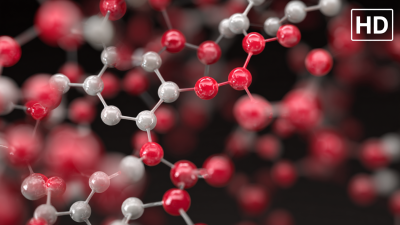
Exploring the Future of Peptide Materials in Biotechnology and Medicine
The field of biotechnology and medicine is experiencing a transformative shift with the integration of Peptide Materials, which are gaining traction due to their versatile applications and therapeutic potential. According to a recent report by Grand View Research, the global peptide therapeutics market is projected to reach USD 62.93 billion by 2025, expanding at a compound annual growth rate (CAGR) of 8.5%. This growth is fueled by the increasing prevalence of chronic diseases and the rising demand for personalized medicine. Peptide Materials are emerging as pivotal components in drug development, biomaterials, and targeted therapies, highlighting their importance in the advancement of medical technologies. As research continues to unveil the multifaceted roles of peptides, understanding their properties and utilization will be crucial for future innovations in this dynamic field.

Innovative Peptide Synthesis Techniques Revolutionizing Biotechnology
Recent advancements in peptide synthesis techniques are significantly reshaping the landscape of biotechnology and medicine. These innovative methods are not only enhancing the efficiency and scalability of peptide production but also enabling the design of more complex and functionally diverse peptides. As researchers delve deeper into the potential of peptides, their applications in drug development, regenerative medicine, and targeted therapies are becoming increasingly prominent.
The global peptide API market reflects this trend, projected to grow at a CAGR of 4.95%. With an estimated value of USD 59.09 billion in 2024, it is anticipated to escalate to USD 91.27 billion by 2033. This rapid growth underscores the rising demand for peptide-based therapies and the role of cutting-edge synthesis techniques in meeting this demand. As the biotechnology sector continues to evolve, the exploration of peptide materials promises to unlock new avenues for therapeutic innovation and improved patient outcomes.
Applications of Peptide Materials in Targeted Drug Delivery Systems
Peptide materials have emerged as innovative tools in the field of biotechnology and medicine, particularly in targeted drug delivery systems. These biomolecules, due to their unique structural properties and biocompatibility, enable the precise delivery of therapeutic agents to specific cells or tissues. According to a report by MarketsandMarkets, the global peptide therapeutics market is projected to reach approximately $67.5 billion by 2025, demonstrating a compound annual growth rate (CAGR) of 9.8% from 2020. This growth is largely driven by the increasing prevalence of chronic diseases and the rising demand for more effective and targeted treatment options.

The application of peptide materials in drug delivery systems comprises several strategies, including conjugation to nanoparticles, incorporation into hydrogels, and the development of peptide-based receptors. For instance, a recent study published in the Journal of Controlled Release highlights that peptide-based nanoparticles can enhance the bioavailability and therapeutic efficacy of anticancer drugs. With their ability to improve the stability and solubility of drug formulations, peptides are becoming indispensable in designing advanced drug delivery platforms. Furthermore, the precision offered by these systems reduces off-target effects, which is crucial in minimizing adverse reactions and enhancing patient compliance.
Advancements in Peptide Engineering for Personalized Medicine Solutions
Peptide engineering has emerged as a pivotal aspect of personalized medicine, promising advancements that tailor treatments to individual patient profiles. By manipulating peptide sequences, researchers can create highly specific therapeutics that interact with biological targets in a more effective manner. This customization allows for enhanced efficacy and reduced side effects, a noteworthy advantage over traditional small molecule drugs. For instance, engineered peptides can be designed to bind selectively to receptors or enzymes involved in disease pathways, leading to more precise interventions.
Moreover, the integration of advanced technologies such as computational modeling and high-throughput screening has accelerated the discovery of novel peptides. These technologies facilitate the identification of promising candidates that can be further optimized for clinical use. Additionally, the combination of peptides with other biomaterials enables innovative delivery systems that enhance stability and bioavailability, making treatment regimens more effective. As the field of peptide engineering continues to evolve, it holds the potential to revolutionize personalized medicine by providing targeted and adaptable solutions for a variety of diseases, ultimately improving patient outcomes.

The Role of Peptide Nanomaterials in Tissue Regeneration and Repair
Peptide nanomaterials are gaining prominence in the fields of biotechnology and medicine, particularly in tissue regeneration and repair. These nanoscale structures, formed from self-assembling peptides, possess unique biochemical properties that mimic the natural extracellular matrix. This makes them ideal candidates for scaffolds in regenerative medicine, providing a supportive environment for cell adhesion, growth, and differentiation. Researchers are increasingly focusing on designing peptide-based nanomaterials that can enhance tissue repair processes, making them crucial for developing advanced therapeutic strategies.
In tissue engineering, peptide nanomaterials can be engineered to release growth factors in a controlled manner. This sustained release not only promotes cellular activities but also improves the integration of engineered tissues with the host’s biological environment. Furthermore, the biocompatibility and biodegradability of these materials reduce the risk of adverse reactions, making them safer alternatives to traditional synthetic scaffolds. As scientists continue to explore and innovate with peptide nanomaterials, their potential to transform tissue regeneration and repair will likely become even more pronounced, paving the way for groundbreaking advancements in regenerative therapies.
Future Perspectives on Regulatory Challenges for Peptide-Based Therapies
The regulatory landscape for peptide-based therapies is evolving rapidly, reflecting advances in biotechnology and the increasing prevalence of these materials in therapeutic applications. As peptide materials demonstrate significant promise in addressing complex medical conditions, regulatory bodies face the challenge of balancing innovation with patient safety. This involves not only rigorous testing and validation processes but also a nuanced understanding of the unique properties of peptides compared to traditional small molecules or biologics.
One of the key challenges lies in establishing standardized protocols for the evaluation of peptide efficacy and safety. Regulatory agencies must develop guidelines that account for the structural diversity and variability of peptide drugs while ensuring that they meet stringent therapeutic thresholds. Collaboration among scientists, regulators, and industry stakeholders is essential to streamline the approval process and foster an environment conducive to innovation. As the demand for peptide-based therapies continues to rise, addressing these regulatory hurdles will be crucial for harnessing the full potential of peptide materials in medicine.
Future Perspectives on Regulatory Challenges for Peptide-Based Therapies
This bar chart illustrates the varying ratings of regulatory challenges associated with peptide-based therapies. The ratings range from 1 to 10, where higher values indicate greater challenges. Regulatory awareness ranks the highest among these challenges, reflecting the necessity for thorough knowledge in the evolving regulatory landscape.
Related Posts
-

Understanding Peptide Materials A Comprehensive Guide for Global Buyers
-

Top 10 Peptide Material Manufacturers from China at the 137th Canton Fair
-

5 Reasons Why Best Peptide Materials Are Essential for Your Global Sourcing Strategy
-

Issues Facing the Best Peptide Materials in Pharmaceutical Applications
-

Unlocking the Future of Biopharmaceuticals with Peptide Materials in Global Supply Chains
-

China's Resilient Growth in Peptide API Manufacturing Amidst US China Trade Tariff Challenges
